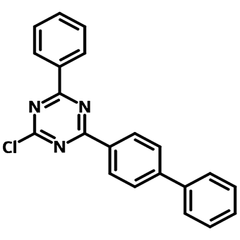BPPTRZ-2Cl
CAS Number 1472062-94-4
Chemistry Building Blocks, Heterocyclic Building Blocks, Materials, MonomersSpecifications | MSDS | Literature and Reviews
2-([1,1'-Biphenyl]-4-yl)-4-chloro-6-phenyl-1,3,5-triazine (BPPTRZ-2Cl) is an OLED intermediate for further synthesis of bipolar host materials or TADF blue emitter materials for organic light-emitting diodes.
1,3,5-triazine core, also referred to as s-triazine, bearing additional chelating groups were also used as ligands for transition metals.
General Information
| CAS Number | 1472062-94-4 |
| Chemical Formula | C21H14ClN3 |
| Molecular Weight | 343.81 g/mol |
| Full Name | 2-([1,1'-Biphenyl]-4-yl)-4-chloro-6-phenyl-1,3,5-triazine |
| Synonyms | 2-chloro-4-(biphenyl-4-yl)-6-phenyl-1,3,5-triazine, PBPTZ |
| Classification / Family | Triazine derivatives, Materials building blocks, OLED intermediates, Small molecule semiconductor building blocks |
Chemical Structure
![Chemical structure of 2-([1,1'-Biphenyl]-4-yl)-4-chloro-6-phenyl-1,3,5-triazine, CAS 1472062-94-4](https://www.ossila.com/cdn/shop/files/BPPTRZ-2Cl-body.png?width=240&height=163)
Product Details
| Purity | >98% |
| Melting Point | 165 °C (lit.) |
| Appearance | Off-white powder |
MSDS Documentation
Literature and Reviews
- Controlled emission colors and singlet–triplet energy gaps of dihydrophenazine-based thermally activated delayed fluorescence emitters, J. Lee et al., J. Mater. Chem. C, 3, 2175-2181 (2015); DOI: 10.1039/C4TC02530J.
- Organic luminescent molecule with energetically equivalent singlet and triplet excited states for organic light-emitting diodes, K. Sato et al., Phys. Rev. Lett., 110, 247401 (2013); DOI: 10.1103/PhysRevLett.110.247401.

![2-([1,1'-Biphenyl]-4-yl)-4-chloro-6-phenyl-1,3,5-triazine](https://www.ossila.com/cdn/shop/files/msds-sheets.jpg?width=60&height=60) BPPTRZ-2Cl MSDS Sheet
BPPTRZ-2Cl MSDS Sheet